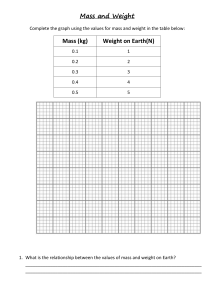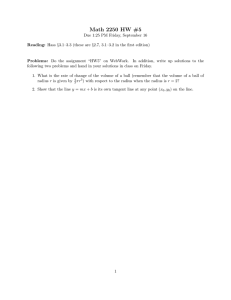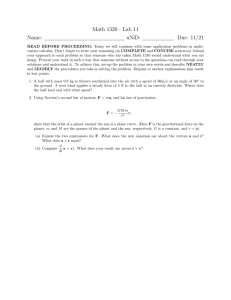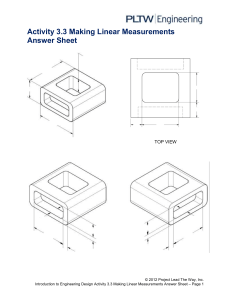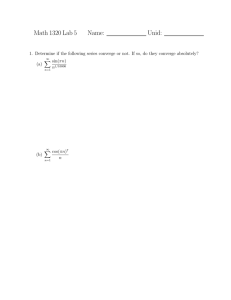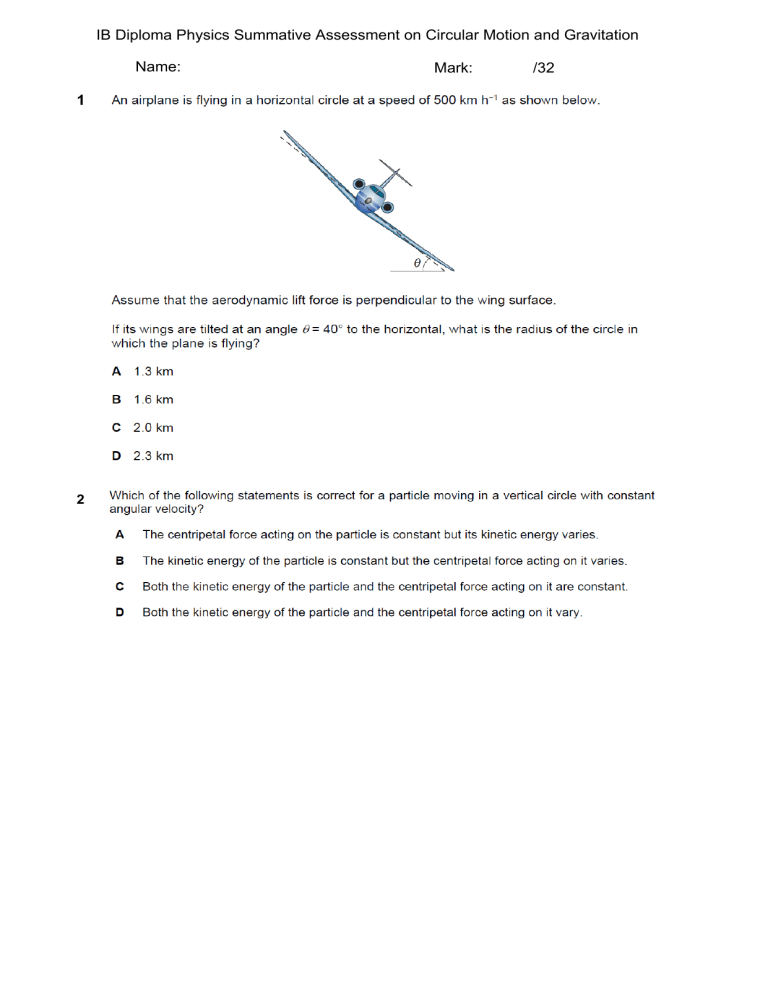
IB Diploma Physics Summative Assessment on Circular Motion and Gravitation Name: 1 2 Mark: /32 3 4 5 6 7 8 1 A large bowl is made from part of a hollow sphere. A small spherical ball is placed inside the bowl and is given a horizontal speed. The ball follows a horizontal circular path of constant radius, as shown in Fig. 2.1. ball 14 cm Fig. 2.1 The forces acting on the ball are its weight W and the normal reaction force R of the bowl on the ball, as shown in Fig. 2.2. wall of bowl R ball e W Fig. 2.2 The normal reaction force R is at an angle θ to the horizontal. (a) (i) By resolving the reaction force R into two perpendicular components, show that the resultant force F acting on the ball is given by the expression W = F tan θ. [2] (ii) State the significance of the force F for the motion of the ball in the bowl. ........................................................................................................................................... ...................................................................................................................................... [1] (b) The ball moves in a circular path of radius 14 cm. For this radius, the angle θ is 28°. Calculate the speed of the ball. speed = ............................................... m s−1 [3] 2 (a) (i) State what is meant by gravitational field strength. ........................................................................................................................................... ........................................................................................................................................... .......................................................................................................................................[1] (ii) Explain why, at the surface of a planet, gravitational field strength is numerically equal to the acceleration of free fall. ........................................................................................................................................... ........................................................................................................................................... .......................................................................................................................................[1] (b) An isolated uniform spherical planet has radius R. The acceleration of free fall at the surface of the planet is g. On Fig. 1.1, sketch a graph to show the variation of the acceleration of free fall with distance x from the centre of the planet for values of x in the range x = R to x = 4R. 1.00 g acceleration of free fall 0.75 g 0.50 g 0.25 g 0 0 R Fig. 1.1 2R 3R x 4R [3] (c) The planet in (b) has radius R equal to 3.4 × 103 km and mean density 4.0 × 103 kg m–3. Calculate the acceleration of free fall at a height R above its surface. acceleration of free fall = ................................................. m s–2 [3] [Total: 8] 3 (a) State Newton’s law of gravitation. ................................................................................................................................................... ................................................................................................................................................... ...............................................................................................................................................[2] (b) The planet Jupiter and one of its moons, Io, may be considered to be uniform spheres that are isolated in space. Jupiter has radius R and mean density ρ. Io has mass m and is in a circular orbit about Jupiter with radius nR, as illustrated in Fig. 1.1. Jupiter radius R density ρ Io nR Fig. 1.1 The time for Io to complete one orbit of Jupiter is T. Show that the time T is related to the mean density ρ of Jupiter by the expression ρT 2 = 3πn3 G where G is the gravitational constant. [4] (c) (i) The radius R of Jupiter is 7.15 × 104 km and the distance between the centres of Jupiter and Io is 4.32 × 105 km. The period T of the orbit of Io is 42.5 hours. Calculate the mean density ρ of Jupiter. ρ = ............................................... kg m–3 [3] (ii) The Earth has a mean density of 5.5 × 103 kg m–3. It is said to be a planet made of rock. By reference to your answer in (i), comment on the possible composition of Jupiter. ........................................................................................................................................... .......................................................................................................................................[1] [Total: 10]
